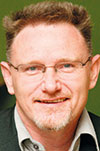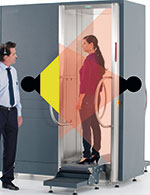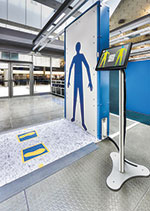
Many fears abound around the use of X-ray technology and similar body scanning equipment used to enhance security in high-risk areas. Hi-Tech Security Solutions discusses the truth behind the technology and how it can minimise theft and security risks.
It is important to differentiate between medical X-rays and X-ray technology used to scan people in airports, ports and in the workplace. Medical X-rays are high-frequency (beyond ultraviolet) radiation, typically on a wavelength of a few ångströms, allowing them to penetrate just about anything but bone/minerals and metals. (Source: biology.stackexchange.com)
Security scanners, on the other hand, emit terahertz radiation, which has a wavelength between microwave and infrared. This is a very low level of energy per photon. Terahertz radiation will not penetrate more than a centimetre of light material, allowing one to find hidden metal objects which reflect terawaves. The intensity of the radiation is relatively low since these scans are also detected by digital cameras, which are quite sensitive. According to the American Association of Physicists in Medicine, the radiation exposure from full body airport scanners is equivalent to what an individual receives every 1.8 minutes on the ground from natural background radiation or equivalent to every
12 seconds during an aeroplane flight. (Source: biology.stackexchange.com)
The current US federal occupational limit of exposure per year for an adult (the limit for a worker using radiation) is “as low as reasonably achievable; however, not to exceed 5000 millirems” above the 300+ millirems of natural sources of radiation and any medical radiation. “A federal advisory committee recommends that the lifetime exposure be limited to a person’s age multiplied by 1000 millirems (for example, for a 65-year-old person would be 65 000 millirems).” (Source: news.mit.edu)
Another differentiator between medical and security X-rays is evident in the software, which produces black and white images for doctors to review in the former case, whereas security X-ray images can be either black and white or in colour. The different colours displayed on the X-ray image are determined by the atomic number of the materials scanned. This helps operators differentiate between the types of materials inside a scanned item, for example, metals, liquids, powders, plastics, etc.

Neil Cameron of Johnson Controls says that while the risks of radiation exposure are greatly reduced in people passing through security scanners, it is necessary that users adhere to the Public Health Amendment Act, 1971 (Act 42 OF 1971) published by the National Department of Health.
X-ray scanners, he says are ideal to allow organisations to control, maintain and access validated data of the people passing through the scanner.
He cautions that the provider of X-ray scanning technology needs to be certified to measure dosage of radiation and is required to keep a secure database of each person’s transactions through the system as well as their dosage exposure. Sensors inside the X-ray cabinet measure radiation for each person as they pass through the scanner and the machine maintains a cumulative record of this data.
Maximum exposure

“The Johnson Controls’ system carefully analyses the frequency at which the person is passing through in order to ensure that they do not reach the maximum dosage exposure. In a number of instances, employees have tried to beat the system by repeatedly passing through the machine in a short space of time. In this way, they force the machine to issue an alert that results in the person not having to pass through the machine on their next entry or exit at the premises.
“The machines are now configured in such a way that employees will pass through the scanner during a randomly selected dummy scan operation. In other words, the X-rays are deactivated for that particular pass, without the employee having any knowledge of this. In this way, they do not exceed the upper limit of exposure, but they believe that they are being reviewed on each pass through the scanner,” says Cameron.
Security X-ray scanners are able to detect any substance that is harder than skin, with a definable shape, such as weapons, platinum, diamonds and other high-value, small quantity products. The scanner takes an initial sample scan of a person, which is stored in the system for future comparison against subsequent scans. Future scans will highlight areas of change, allowing security personnel to further investigate and, for instance, order a more thorough body search in a closed environment.
Johnson’s low-dosage scatter scan is able to provide a high-definition digital format image of very small particles, making it ideal for use in the mining environment as well as in prisons. The X-ray system identifies areas of difference on people passing through the scanner but the machine does require human intervention when differences are detected. The person is then placed in a holding room until the operator has reviewed the scan to identify whether a search is required and on which body part the foreign object is suspected to be.
“To put employees at ease, male employees are viewed on the X-ray machine and searched, if necessary, only by male security officers, while female employees are scanned/searched by female security officers,” Cameron points out.
Wave goodbye to X-ray

Jayne Nel of Vantage MDT says that the Milliwave Full Body Security Scanner they provide employs millimetre wave technology that enables quick and automatic detection of potentially dangerous items in a non-invasive and sensitive manner. The technology, which originated for the aviation industry, was developed specifically to bypass the privacy and health issues around X-rays.

Millimetre wave (mmw) scanners produce detailed full-body images of people, using ultrahigh-frequency millimeter wave radiation rather than X-rays. Millimetre wave scanners produce a special type of microwave with wavelengths that fall in a range exactly between 0.001 metres (1 millimetre) and 0.01 metres (10 millimetres). In other words, the waves emitted by mmw scanners are much larger and therefore have less impact on small structures, such as human proteins and nucleic acids. (Source: science.howstuffworks.com)
The Milliwave Full Body Security Scanner uses automated target recognition (ATR) software that renders every subject as a generic outline, with suspicious areas highlighted. It will display the words ‘pass’, ‘inadequate’ or ‘fail’, depending on whether it detects a foreign object or not. Operators are necessary to physically operate the machine but they do not become involved in the actual detection process.
For privacy reasons, the operator sees a generic body shape (avatar) on the screen which is highlighted with a red mark on a specific body area that requires further investigation by security officers.
Subject to the stringent health regulations of the TSA (USA) and ECAC (Europe), these scanners work on the following principle: the machine sends millimetre waves in short succession which reflect off the skin surface. The detection software uses machine-trained algorithms to search for anomalies that would indicate unusual objects of all material types, rather than looking for specific items.
“Because it passes aviation standards, it has been through rigorous testing and is therefore an attractive option for other sectors including mining, manufacturing and distribution. Due to the fact that it does not pose a health risk, it can be used to scan staff on a daily basis. A further benefit is that scans take only 32 milliseconds, meaning that high throughputs of personnel are quickly achieved, resulting in minimal disruption,” Nel points out.

© Technews Publishing (Pty) Ltd. | All Rights Reserved.